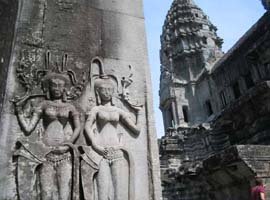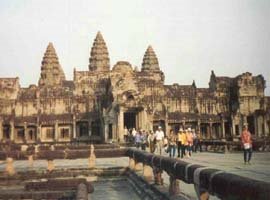Angkor Wat Cambodia Part 3
 Angkor Wat Cambodia is the highest achievement of Khmer temple architecture, and is today the "flagship" of the temples at Angkor Cambodia. The temple is a huge pyramid structure. The compound at Angkor Wat Cambodia covers an area of 1,500 by 1,300 m (4,920 by 4,265 ft) and is surrounded by a vast moat 180 m (590 ft) wide. Along the causeway leading to the enormous entrance gate are balustrades shaped as giant serpents, which are believed to represent emblems of cosmic fertility.
Angkor Wat Cambodia is the highest achievement of Khmer temple architecture, and is today the "flagship" of the temples at Angkor Cambodia. The temple is a huge pyramid structure. The compound at Angkor Wat Cambodia covers an area of 1,500 by 1,300 m (4,920 by 4,265 ft) and is surrounded by a vast moat 180 m (590 ft) wide. Along the causeway leading to the enormous entrance gate are balustrades shaped as giant serpents, which are believed to represent emblems of cosmic fertility.The Angkor Wat temple consists of a towering complex of terraces and small buildings that are arranged in a series of three diminishing stories and surmounted by five towers. The roofed and unroofed structures are covered with bands of finely carved stone sculptures.
The walls are covered with carved reliefs that illustrate Hindu mythology, principally scenes relating to the god Vishnu, to whom the temple was dedicated. The "mass of bas-relief carving is of the highest quality and the most beautifully executed in Angkor Cambodia." All the temple mountains of Angkor Cambodia were filled with three-dimensional images and every inch of the walls are covered by sculptures.
 In the beginning of AD1200, the Angkor and the Khmer empire started to decline. When jayavarman VII died, the Thai Empire in the West emerged as a major power in the region. The Thai capital was moved to Ayudhya, near Angkor Cambodia, and obviously threatened the Cambodian kingdom. In AD1389 the Thais attacked Angkor, and the city fell into the hands of the Thais. The 15th-century conquest of the Khmer kingdom by the Thais resulted (1431) in the final abandonment of Angkor Cambodia. The city was deserted and the capital was moved to Eastward to the region of the present capital Phnom Penh Cambodia.
In the beginning of AD1200, the Angkor and the Khmer empire started to decline. When jayavarman VII died, the Thai Empire in the West emerged as a major power in the region. The Thai capital was moved to Ayudhya, near Angkor Cambodia, and obviously threatened the Cambodian kingdom. In AD1389 the Thais attacked Angkor, and the city fell into the hands of the Thais. The 15th-century conquest of the Khmer kingdom by the Thais resulted (1431) in the final abandonment of Angkor Cambodia. The city was deserted and the capital was moved to Eastward to the region of the present capital Phnom Penh Cambodia.Miraculously, very little damage has been made on the Angkor region as a result of the bloody civil that has terrorized the Cambodia for over 30 years. The Khmer Rouge, an extreme-left organization has actively organized guerrilla activities against Prince Sihanouk's government. In 1975, many Buddhist monks who lived in the Angkor temples were massacred along with the majority of the Buddhist population as a result of a "social reorganization".
However, Angkor Wat Cambodia suffered very little structural damage in that attack. Today, archeologists from all over the world are actively involved in the restoration process of the temples. Much of the history of the "Lost city" of Angkor is still a mystery, but Angkor has entered the "Coca Cola" and "Kodak" age, and as Cambodia is becoming more developed, the mystical atmosphere at Angkor will disappear.
Angkor Wat Cambodia Part 1
Angkor Wat Cambodia Part 2
Source: www.geocities.com


















0 Comments:
Post a Comment
<< Home